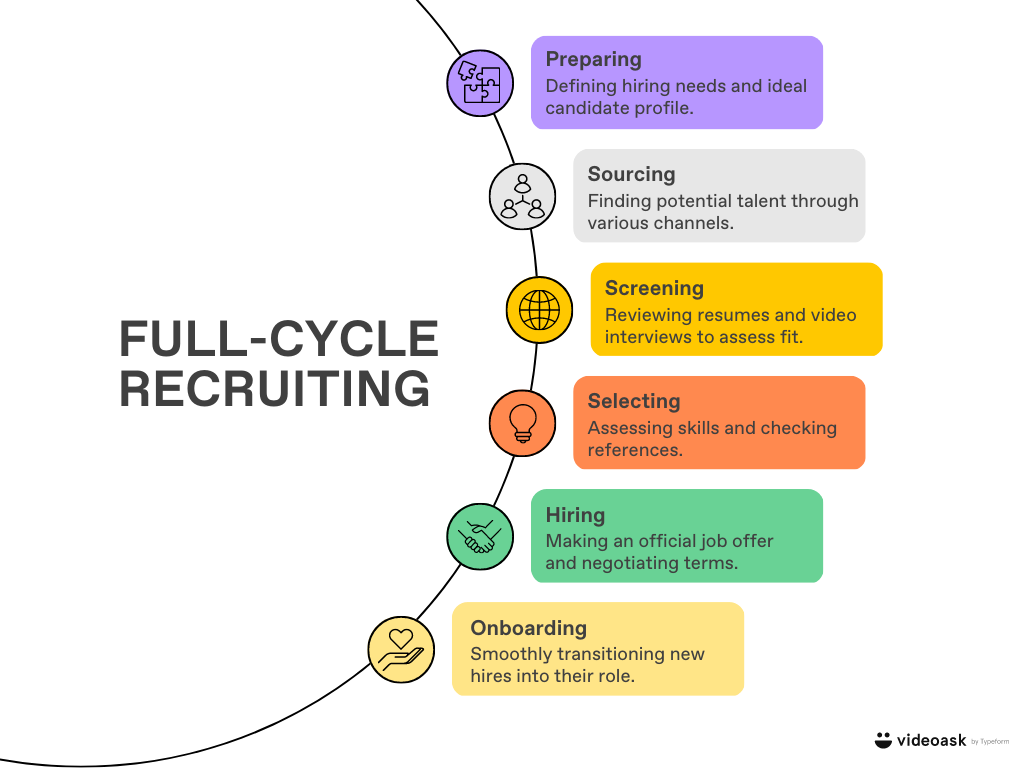
What is full-cycle recruiting?
Author: Cat Mcilroy
Published: March 2023
A strong recruitment strategy is key to the success of any organization. Getting it right means hiring the best talent with the right skills and experience to excel in their new role while quickly becoming an asset to your company.
Full-cycle recruiting, or end-to-end recruiting as it’s sometimes called, is a recruitment strategy that encompasses all aspects of the recruitment process from start to finish. A single recruiter or agency handles every stage of the recruitment life cycle, from conducting an intake meeting and creating the job description, right up to the new hire’s onboarding experience in the organization.
Full-cycle recruiting benefits everyone involved–the candidate, the recruiter, and the organization–by speeding up the time-to-hire, creating a consistent candidate experience, avoiding communication gaps, and ultimately improving the quality of hires. We can break down the stages of the hiring process into the following 6 steps:
Preparing
Sourcing
Screening
Selecting
Hiring
Onboarding

In this first stage of the hiring process, a recruiter works with the hiring manager to understand the hiring needs and identify who the ideal candidate for the role would be. They do this by defining the skills, competencies, and experience a candidate should have to be successful in the role.
They also create a job description outlining the main responsibilities and duties of the role, as well as other details like extra benefits and information about the organization and department.
Next up comes sourcing potential talent. Recruiters use a range of channels to find people who match the ideal candidate profile. As well as posting on social media sites and career websites, they may use other methods like internal recruiting, employee referrals, and identifying passive talent to find the best candidates.
Depending on the candidate pool available for the role, sourcing can be a tricky step. If the number of job opportunities outweighs the number of people actively searching in that field, the market becomes highly competitive and organizations have a hard time engaging, attracting, and recruiting the right people. The battle is on to find the best talent out there and connect with candidates through the noise of 100s of other recruiters trying to do exactly the same thing. A great way to stand out from the crowd and make things a little more personal is by sharing an interactive video using VideoAsk in your introductory messages to potential candidates. Let them navigate through the video at their own pace to find out about the role and company, put faces to their future teammates, and ask any questions they may have.
After finding candidates, the recruiter reviews their resumes, applications, and cover letters to determine who should move forward to the next stage of the hiring process. To help with the shortlisting decision, they may conduct a pre-recorded video interview or phone call to screen candidates, assess the relevance of their experience, and get a sense of how they’d fit into the company culture. This also gives candidates an opportunity to ask any questions about the role and company.
Often lengthy and laborious, the screening stage can be made way more efficient with access to the right tools. Instead of spending hours scheduling and conducting screening interviews, try sharing pre-recorded video interviews and arranging live follow-up interviews automatically using VideoAsk.
Candidates who pass the initial screening with the recruiter move on to the interview stage, where their skills are assessed in more detail by the hiring team. The nature of these interviews and assessments varies depending on the role at hand, but can include virtual or face-to-face interviews, specific skills tests, video presentations, and writing assignments, among other tasks.
Once the hiring team and recruiter have come to a decision on who the best candidate for the job is, the recruiter carries out a background check and contacts the candidate’s nominated references. At this stage, it’s also important to remember unselected candidates. Even though you’ve decided they’re not the right fit for the role at this time, it’s always a good idea to maintain a positive candidate experience. Not only out of respect for the time and effort they’ve invested in the recruitment process, but also because unselected candidates often talk. They share their experiences–positive or negative–with their network or on online platforms like Glassdoor. Use VideoAsk to handle rejections with a human touch but at scale, and turn unselected candidates into customers and brand ambassadors.
This is the most exciting (and important) part of the process. The recruiter contacts the best-suited candidate to make them an official job offer. They go over the salary and terms of the offer including things like company perks, PTO allowance, performance bonus, and stock options. Depending on the candidate’s expectations, they may negotiate some of the terms to make sure both sides are happy.
When the candidate accepts the offer, it becomes the full-cycle recruiter’s responsibility to ensure that the new hire transitions smoothly into their new role. Some organizations even have a dedicated onboarding specialist for this part of the recruitment cycle, or it could be the HR Operations team or the new hire’s direct manager who take on responsibility for the onboarding. They familiarize the successful candidate with their new team and the company culture, and make sure they’re set up with all the necessary work equipment, software, and relevant information to feel prepared and ready to dive into their new role.